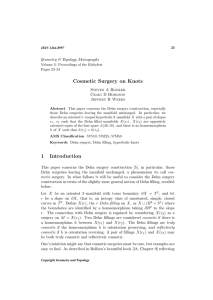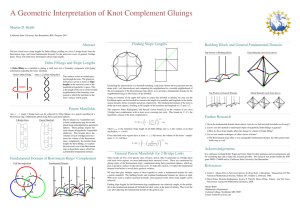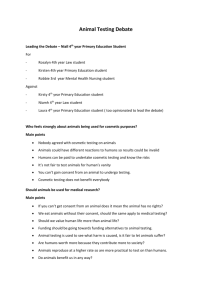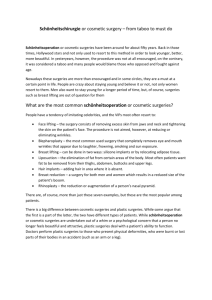Cosmetic Surgery on Knots Geometry & Topology Monographs Steven A Bleiler
advertisement
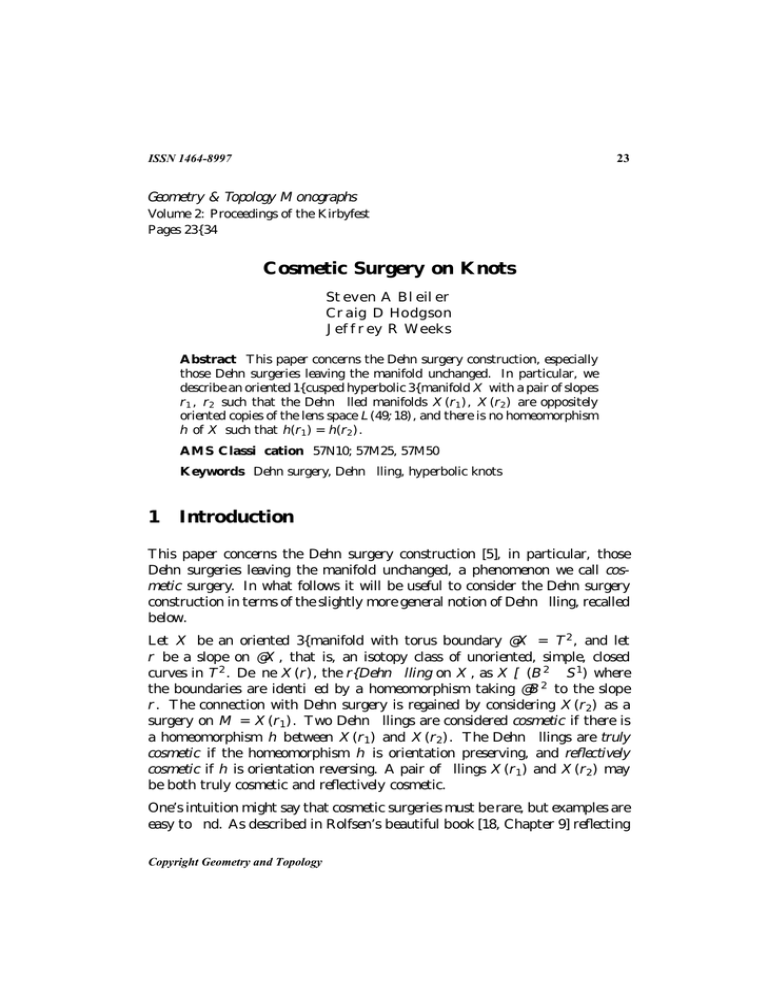
23
ISSN 1464-8997
Geometry & Topology Monographs
Volume 2: Proceedings of the Kirbyfest
Pages 23{34
Cosmetic Surgery on Knots
Steven A Bleiler
Craig D Hodgson
Jeffrey R Weeks
Abstract This paper concerns the Dehn surgery construction, especially
those Dehn surgeries leaving the manifold unchanged. In particular, we
describe an oriented 1{cusped hyperbolic 3{manifold X with a pair of slopes
r1 , r2 such that the Dehn lled manifolds X(r1 ), X(r2 ) are oppositely
oriented copies of the lens space L(49; 18), and there is no homeomorphism
h of X such that h(r1 ) = h(r2 ).
AMS Classication 57N10; 57M25, 57M50
Keywords Dehn surgery, Dehn lling, hyperbolic knots
1
Introduction
This paper concerns the Dehn surgery construction [5], in particular, those
Dehn surgeries leaving the manifold unchanged, a phenomenon we call cosmetic surgery. In what follows it will be useful to consider the Dehn surgery
construction in terms of the slightly more general notion of Dehn lling, recalled
below.
Let X be an oriented 3{manifold with torus boundary @X = T 2 , and let
r be a slope on @X , that is, an isotopy class of unoriented, simple, closed
curves in T 2 . Dene X(r), the r{Dehn lling on X , as X [ (B 2 S 1 ) where
the boundaries are identied by a homeomorphism taking @B 2 to the slope
r. The connection with Dehn surgery is regained by considering X(r2 ) as a
surgery on M = X(r1 ). Two Dehn llings are considered cosmetic if there is
a homeomorphism h between X(r1 ) and X(r2 ). The Dehn llings are truly
cosmetic if the homeomorphism h is orientation preserving, and reflectively
cosmetic if h is orientation reversing. A pair of llings X(r1 ) and X(r2 ) may
be both truly cosmetic and reflectively cosmetic.
One’s intuition might say that cosmetic surgeries must be rare, but examples are
easy to nd. As described in Rolfsen’s beautiful book [18, Chapter 9] reflecting
Copyright Geometry and Topology
24
Steven A Bleiler, Craig D Hodgson and Jeffrey R Weeks
in the plane of the paper shows that p=q and −p=q surgeries on an amphicheiral
knot in the 3{sphere yield oppositely oriented copies of the same manifold, and
performing 1=n surgery on the unknot always produces a consistently oriented
3{sphere. See Figure 1.
p/q
-p/q
-p/q
1/n
change
isotopy
orientation
rotate
180°
twist
1/0
Figure 1
In both these cases, however, there exists a homeomorphism of the torally
bounded knot exterior X which takes one surgery slope to the other. We call
two slopes equivalent if such a homeomorphism exists. Truly cosmetic (resp.
reflectively cosmetic) Dehn llings X(r1 ) and X(r2 ) are considered mundane
when there is an orientation preserving (resp. orientation reversing) homeomorphism of X taking r1 to r2 . Cosmetic Dehn llings which are not mundane
are exotic.
There is one easy way to nd exotic cosmetic llings: swapping the sides of a
Heegaard splitting of certain lens spaces can produce true and reflective exotic
cosmetic surgeries on the unknot. In particular, p=q and p=q 0 surgeries yielding
the lens spaces L(p; q) and L(p; q 0 ) where qq 0 1 mod p and q 0 6= q mod p
perform this happy trick, for example 17=2 and 17=9 surgeries. So we require
the space X not to be homeomorphic to B 2 S 1 in our denition of exotic
cosmetic llings.
Now things are much harder. Indeed, recent results in surgery theory suggest
that examples of exotic cosmetic surgeries are few and far between. For example,
the solutions to the knot complement problems in S 3 [11] and in S 2 S 1 [6],
phrased in the language here, state that the 3{sphere S 3 and the manifold
S 2 S 1 never arise via cosmetic surgery. So one thinks of cosmetic surgeries
as occurring on knots in more general manifolds.
Similar results hold when the rst Betti number of the manifold is positive. For
example, Boileau, Domergue, and Mathieu [3] showed in 1995 that if X is irreGeometry and Topology Monographs, Volume 2 (1999)
Cosmetic Surgery on Knots
25
ducible and the core of the surgered solid torus is homotopically trivial in such
an X(r1 ), then for r2 distinct from r1 , the manifold X(r2 ) is never even simple
homotopy equivalent to X(r1 ). An extension and sharpening of this result was
given by M Lackenby [13] shortly thereafter. Assume that X is irreducible and
atoroidal and, as before, that the core of the surgered torus is homotopically
trivial in X(r1 ) with rst Betti number positive. Then Lackenby’s theorem
shows that if at least one of the slopes r2 and r3 has a suciently high geometric intersection number with r1 , X(r2 ) and X(r3 ) are orientation preserving
homeomorphic if and only if r2 = r3 , and X(r2 ) and X(r3 ) are orientation
reversing homeomorphic if and only if the surgery core is amphicheiral and
r2 = −r3 .
The assumption of homotopic triviality is important here, as illustrated by certain Seifert bre spaces. As rst shown by Mathieu [14], 9=1 and 9=2 surgeries
on the right hand trefoil yield oppositely oriented copies of the same Seifert bre
space. The slopes are inequivalent since they have dierent distances from the
meridian, and any homeomorphism of the knot exterior must take the meridian
to itself. The existence of Seifert bred cosmetic surgeries has a particularly
nice picture in the Kirby calculus [18, Chapter 9] and depends on the existence
of an exceptional bre of index 2. The key property of such an exceptional bre
is that after orientation reversal, the type of an exceptional bre of index 2 can
be restored via a twist. See Figure 2 which begins with a surgery description
of the trefoil knot K in S 3 . (This comes from the Seifert bration of S 3 over
S 2 with a trefoil knot as regular bre and two exceptional bres of order 2 and
3 | see Seifert [20, sections 3,11], Montesinos [16, chapter 4].)
The same construction gives examples of exotic cosmetic surgeries on Seifert
bre spaces with positive rst Betti number, starting with surgery descriptions
of Seifert bred spaces over higher genus surfaces as in [16, gure 12, p. 146].
This observation was also used by Rong [19] to classify the cosmetic surgeries
where X carries a Seifert bration and the surgery yields a Seifert bre space.
One consequence of the classication is that all the exotic cosmetic surgeries
on Seifert bre spaces are reflective. Another consequence of this technique is
the fact that if a Seifert bred X admits a pair of cosmetic surgeries yielding a
Seifert bre space, it admits an innity of such pairs.
2
Cosmetic surgery on hyperbolic manifolds
From Seifert bred cosmetic surgeries it is fairly easy to construct examples
of cosmetic surgeries on graph manifolds, so the question arises as to whether
Geometry and Topology Monographs, Volume 2 (1999)
26
Steven A Bleiler, Craig D Hodgson and Jeffrey R Weeks
-3/1
2/1
K
0/1
fill
fill
-3/1
-3/2
-3/1
2/1
3/1
2/1
0/1
0/1
left hand twist
on 3/1 filling
change orientation
3/1
-3/1
-3/1
3/1
-2/1
2/1
1/1
0/1
isotopy
interchanging
index 3 fibres
right hand twist
on index 2
fibre
-3/1
3/1
-2/1
0/1
Figure 2
there are any hyperbolic examples. Such examples are unexpected because of
the general theory of 1{cusped hyperbolic manifolds. For example, a theorem
similar to M Lackenby’s but for homotopically non-trivial knots and showing
there can be only nitely many cosmetic surgeries on a hyperbolic knot is given
below. Throughout this paper hyperbolic 3{manifolds are assumed to be complete and of nite volume.
Geometry and Topology Monographs, Volume 2 (1999)
Cosmetic Surgery on Knots
27
Theorem 1 Let X be a 1{cusped, orientable hyperbolic 3{manifold. Then
there exists a nite set of slopes E on @X , such that if r1 and r2 are distinct
slopes outside E , X(r1 ) and X(r2 ) homeomorphic implies that there exists an
orientation reversing isometry h of X such that h(r1 ) = r2 . In particular, if
X is a classical knot complement, then the knot is amphicheiral and r1 = −r2 .
Proof By Thurston’s theory of hyperbolic Dehn surgery [T1], we can choose E
so that each lling outside E gives a hyperbolic manifold in which the surgery
core circle is isotopic to the unique shortest closed geodesic. Assume r1 ; r2 are
outside E and X(r1 ) is homeomorphic to X(r2 ). Then by Mostow rigidity there
is an isometry X(r1 ) ! X(r2 ) taking the core geodesic C1 to core geodesic C2 .
This restricts to a homeomorphism of X taking r1 to r2 . The following lemma
then completes the proof.
Lemma 2 Let X be a 1{cusped, orientable hyperbolic 3{manifold. If h: X !
X is a homeomorphism which changes the slope of some peripheral curve, then
h is orientation reversing. If X is a classical knot complement, then h takes
each slope r to −r.
Proof By Poincare duality, the map induced by inclusion H1 (@X; R) !
H1 (X; R) has a 1{dimensional kernel K . The hyperbolic structure on the
interior of X gives a natural Euclidean metric on H1 (@X; R) = R2 , dened
up to similarity. By Mostow Rigidity, h is homotopic to an isometry, hence
h : H1 (@X; R) ! H1 (@X; R) is an isometry. Further, K and its orthogonal
complement are preserved by h so each is a +1 or −1 eigenspace for h . It
follows that if h is orientation preserving then h = identity, so h does not
change the slope of any peripheral curve.
If X is a classical knot complement, then h preserves both the longitude and
meridian up to sign (using the solution to the knot complement problem [11]).
Hence, if h is orientation reversing, each slope is taken to its negative.
The theorem strongly suggests that nding cosmetic surgeries on hyperbolic
manifolds that yield hyperbolic manifolds is hard, perhaps impossible. Instead
one looks to nd cosmetic surgeries that yield non-hyperbolic manifolds, such as
the lens spaces. Another reason to look here is that there are cosmetic surgeries
in the solid torus. In fact, Berge [1] and Gabai ([6], [7]) classify those knots in
B 2 S 1 which have inequivalent slopes which ll to B 2 S 1 .
From their classication, these knots are certain 1{bridge braids and, with a
unique exception where there are three such slopes, these knots have exactly
Geometry and Topology Monographs, Volume 2 (1999)
28
Steven A Bleiler, Craig D Hodgson and Jeffrey R Weeks
two slopes which yield a solid torus when lled. The meridian of this new solid
torus, however, is quite dierent from the meridian of the original solid torus.
Indeed, as originally shown by C Gordon [9], if one performs p=q {surgery on a
knot in a solid torus and again obtains a solid torus, the meridian of this new
solid torus is given by the slope p=(k2 q), where k is the winding number of the
original knot in the solid torus. Now, from such a knot in a solid torus it is easy
to construct a torally bounded 3{manifold having a pair of slopes yielding lens
spaces by attaching a solid torus to the outside of the solid torus in which the
knot lies. The lens spaces produced are determined by the relation of this last
attaching curve to the meridians described above. This has led to a conjectural
classication of the llings on hyperbolic knot complements in the 3{sphere
which yield lens spaces, see [10].
Of course, the purpose here is to construct examples where lling on the appropriate slopes yields homeomorphic lens spaces. This requirement produces a severe number theoretic obstruction, namely, that the outside attaching slope r be
simultaneously a (p; q) and (p; q 0 ) curve with qq 0 1 mod p or q q 0 mod p
with respect to our two meridians. (See [17] or [4].) The number p is, of course,
the geometric intersection number of r and the meridians, and is commonly referred to as the distance between the two slopes. This already puts powerful
restrictions on the allowable slopes as given a pair of slopes r1 = a1 =b1 and
r2 = a2 =b2 , there are exactly two slopes equidistant from r1 and r2 . For this
one notes that the geometric intersection number is just ja1 b2 − b1 a2 j, so if
r = c=d is equidistant from r1 and r2 then either a1 d − b1 c = a2 d − b2 c or
a1 d−b1 c = b2 c−a2 d. In the former case it follows that c=d = (a1 −a2 )=(b1 −b2 )
and in the latter that c=d = (a1 + a2 )=(b1 + b2 ).
The precise lens spaces produced are then determined by the following.
Lemma 3 Let M be the manifold obtained by a=b and c=d Dehn llings on
the two boundary components of T 2 [0; 1], where gcd(a; b) = gcd(c; d) = 1.
Let a ; b be integers such that a b − b a = 1. Then M is the lens space L(p; q)
p
bc − ad
where = .
q
a d − b c
Proof The linear automorphism of T 2 given by the matrix
−1 a a
b
−a
=
b b
−b a
takes the slopes
a
c
0
bc − ad
and
to
and .
b
d
1
a d − b c
Geometry and Topology Monographs, Volume 2 (1999)
Cosmetic Surgery on Knots
29
A further restriction on r arises from hyperbolicity. Considering the complements of these braids in the solid torus as link exteriors, one notes that of the
six types listed in the Berge{Gabai classication only four are atoroidal and
acylindrical, and hence by Thurston ([22], [23]) correspond to 2{cusped hyperbolic manifolds. If one wishes to construct hyperbolic examples by the above
construction, the slope r must lie in the hyperbolic region of the Dehn surgery
space of these manifolds. After lling on r, there is also the question as to
whether the slopes r1 and r2 are indeed inequivalent.
Both these points are exemplied by a family of braids for which the construction gives distinct llings yielding homeomorphic lens spaces. These examples
arise from the Berge braids of \Type IV" and the Pythagorean triples of the
form (s; t; u) = (2k + 1; 2k(k + 1); 2k2 + 2k + 1). In particular, denoting by Wn
the product of the rst n − 1 standard braid generators, the braids Ws1 Wt−s
give rise to a family of torally bounded 3{manifolds each with one pair of slopes
yielding oppositely oriented copies of L(u + s; s + 2) = L(2(k + 1)2 ; 2k + 3) and
another pair of slopes yielding oppositely oriented copies of L(u − s; s − 2) =
L(2k2 ; 2k − 1). However, it turns out that each of these torally bounded 3{
manifolds has the structure of an amphicheiral graph manifold. This was initially suggested by computer calculations via SnapPea [We], then conrmed,
after using lots of string, by a direct analysis via the Montesinos trick ([15],
[2]). So these examples are neither hyperbolic nor surgeries on inequivalent
slopes.
3
A surprising example
The preceding discussion makes the following example even more striking. Our
construction will produce an oriented 1{cusped hyperbolic manifold X with an
exotic pair of reflective cosmetic Dehn llings. The lled manifolds X(r1 ) and
X(r2 ) will be oppositely oriented copies of the lens space L(49; 18), and the
cusped manifold X will be presented naturally as a knot exterior in S 2 S 1 .
Begin with the now infamous 1{bridge braid W3−1 W73 in a solid torus. This
braid and its mirror image are the unique 1{bridge braids with three distinct
slopes which yield a solid torus when lled (see Figure 3). When the solid torus
T in which the braid lies is considered to be a standard torus in the 3{sphere
S 3 , these special slopes are given by 1=0, 18=1, and 19=1. Filling on these
slopes produces solid tori whose meridians are represented by the 1=0, 18=49,
and 19=49 slopes on the boundary of T .
Geometry and Topology Monographs, Volume 2 (1999)
30
Steven A Bleiler, Craig D Hodgson and Jeffrey R Weeks
-1
3
W3 W7
Figure 3
For the pair r1 = 18=49 and r2 = 19=49 it follows from our discussion above
that the slopes 1=0 and 37=98 are equidistant to r1 and r2 . Of course, attaching
a solid torus to the p=q curve on a standard solid torus in S 3 is the same as
performing q=p surgery on the core of the complementary solid torus. Choosing
1=0 then, our braid becomes a knot in S 2 S 1 representing 7 in 1 = Z. An
analysis by SnapPea [24] shows that the exterior of this knot is hyperbolic and
that there is no homeomorphism taking the slope 18=1 to 19=1. (Alternatively,
the Montesinos trick can be used to show this knot exterior to be atoroidal and
acylindrical.)
So if lling on these slopes does indeed produce homeomorphic manifolds, we
have the example we seek. But now an easy exercise, using Lemma 3 or the
Kirby calculus (see Figure 4), shows that lling on these slopes produces the
manifolds L(49; −18) and L(49; −19).
Since (−18)(−19) = 342 and 749 = 343, the classication of lens spaces shows
that one has obtained oppositely oriented copies of the lens space L(49; 18).
Remark In SnapPea’s notation, these cosmetic surgeries are given by the
(0; 1) and (1; 1) llings on the cusped hyperbolic manifold m172.
Geometry and Topology Monographs, Volume 2 (1999)
31
Cosmetic Surgery on Knots
18/1
19/1
0/1
0/1
19/49
18/49
0/1
0/1
-49/19
-49/18
Figure 4
4
Concluding Remarks
To date this is the only known example of exotic cosmetic surgery on a hyperbolic knot exterior. As it and all the Seifert bred examples are reflective, it
seems appropriate to make the following conjecture, given in problem 1.81 of
Kirby’s problem list [12].
Geometry and Topology Monographs, Volume 2 (1999)
32
Steven A Bleiler, Craig D Hodgson and Jeffrey R Weeks
Conjecture 1 (Cosmetic surgery conjecture) Exotic cosmetic surgeries are
never truly cosmetic.
An equivalent form of this conjecture is the
Conjecture 2 (Oriented knot complement conjecture) If K1 and K2 are
knots in a closed, oriented 3{manifold M whose complements are homeomorphic via an orientation-preserving homeomorphism, then there exists an
orientation-preserving homeomorphism of M taking K1 to K2 .
We close with two further conjectures and a comment. Our earlier theorem
suggests the following:
Conjecture 3 Cusped hyperbolic manifolds admit no cosmetic llings, true
or reflective, yielding hyperbolic manifolds.
Conjecture 4 Closed geodesics in a hyperbolic 3{manifold are determined by
their complements (even allowing orientation reversing homeomorphisms).
Remarks (3) ) (4) but they are not equivalent as it may happen that the
core of one of the surgeries is not isotopic to a closed geodesic. Some evidence
for these conjectures has been provided by a computer search: No manifold
in the Hodgson{Weeks census of 11,031 low-volume closed, orientable hyperbolic 3{manifolds is obtained by two inequivalent llings on a manifold in the
Hildebrand{Weeks census of 4,815 cusped, orientable hyperbolic 3-manifolds
triangulated by at most 7 ideal simplices. (All of these hyperbolic manifolds
are incorporated in SnapPea [24].)
Question Does there exist a pair of exotic cosmetic llings which are simultaneously true and reflective?
One can also ask the above questions with homeomorphism replaced by homotopy equivalence or simple homotopy equivalence (see [3] for a version which
is dierent because the knots are null-homotopic). We note that there is a
hyperbolic knot exterior in a lens space with a pair of slopes which yield nonhomeomorphic but orientation preserving homotopy equivalent lens spaces. It
is obtained by replacing the 1=0 slope in our construction above by 37=98.
Geometry and Topology Monographs, Volume 2 (1999)
Cosmetic Surgery on Knots
33
Acknowledgements Steven Bleiler is partially supported by a grant from
the Portland State University Faculty Development Program. Craig Hodgson
is partially supported by grants from the Australian Research Council. Jerey
Weeks is partially supported by US National Science Foundation grant DMS{
9803362.
References
[1] J Berge, The knots in D2 S 1 which have nontrivial Dehn surgeries that
yield D2 S 1 , Topology and its Applications, 38 (1991) 1{20, and private
communication
[2] S Bleiler, Prime tangles and composite knots, from: \Knot theory and Manifolds", Springer{Verlag Lecture notes in Mathematics, 1144 (1985) 1{13
[3] M Boileau, M Domergue, Y Mathieu, Chirurgies de Dehn le long de nuds
nul homotopes, preprint
[4] E J Brody, The topological classication of the lens spaces, Ann. of Math. 71
(1960) 163{184
[5] M Dehn, Über die Topologie des dreidimensionalen Raumes, Math. Ann. 69
(1910) 137{168
[6] D Gabai, Foliations and the topology of 3-manifolds: II, J. Dierential Geom.
26 (1987) 461{478
[7] D Gabai, Surgery on knots in solid tori, Topology, 28 (1989) 1{6
[8] D Gabai, 1-bridge braids in solid tori, Topology Appl. 37 (1990) 221{235
[9] C McA Gordon, Dehn surgery on satellite knots, Transactions AMS, 275
(1983) 687{708
[10] C McA Gordon, Dehn surgery on knots, Proceedings of the International
Congress of Mathematicians, Vol. I, II (Kyoto, 1990) Math. Soc. Japan, Tokyo
(1991) 631{642
[11] C McA Gordon, J Luecke, Knots are determined by their complements, J.
Amer. Math. Soc. 2 (1989) 371{415
[12] R Kirby, Problems in low-dimensional topology, AMS/IP Studies in Advanced
Mathematics, volume 2, part 2, Amer. Math. Soc. (1997)
[13] M Lackenby, Dehn surgery on knots in 3-manifolds, J. Amer. Math. Soc. 10
(1997) 835{864
[14] Y Mathieu, Sur les nuds qui ne sont pas determines par leur compl
ement et
problemes de chirurgie dans les varietes de dimension 3, PhD thesis, Marseille
(1990)
[15] J M Montesinos, Surgery on links and double branched coverings of S 3 , Annals of Math. Studies, 84 (1975) 227-260
Geometry and Topology Monographs, Volume 2 (1999)
34
Steven A Bleiler, Craig D Hodgson and Jeffrey R Weeks
[16] J M Montesinos, Classical Tessellations and Three-Manifolds, Springer (1987)
[17] K Reidemeister, Homotopieringe und Linsenräume, Abh. Math. Sem. Univ.
Hamburg, 11 (1935) 102{109
[18] D Rolfsen, Knots and Links, Publish or Perish Inc. (1976)
[19] Y W Rong, Some knots not determined by their complements, from: \Quantum
topology", Ser. Knots Everything, 3, World Sci. Publishing, River Edge, NJ,
(1993) 339{353
[20] H Seifert, Topologie dreidimensionaler gefaserter Räume, Acta Math. 60
(1933) 147{238, English translation in: H Seifert and W Threlfall, A textbook
of topology, Academic Press, (1980)
[21] W P Thurston, The geometry and topology of 3-manifolds, Princeton Univ.
Math. Dept. (1979)
[22] W P Thurston, Three-dimensional manifolds, Kleinian groups and hyperbolic
geometry, Bull. Amer. Math. Soc. 6 (1982) 357{381
[23] W P Thurston, Hyperbolic structures on 3-manifolds, I, Annals of Math. 124
(1986) 203{246
[24] J Weeks, SnapPea: a computer program for creating and studying hyperbolic
3-manifolds, available from http://www.northnet.org/weeks
Department of Mathematics, Portland State University
Portland, OR 97207-0751, USA
Department of Mathematics, University of Melbourne
Parkville, Victoria 3052, Australia
15 Farmer Street, Canton, NY, USA
Email: steve@mth.pdx.edu cdh@ms.unimelb.edu.au weeks@northnet.org
Received: 27 January 1999
Revised: 15 June 1999
Geometry and Topology Monographs, Volume 2 (1999)
